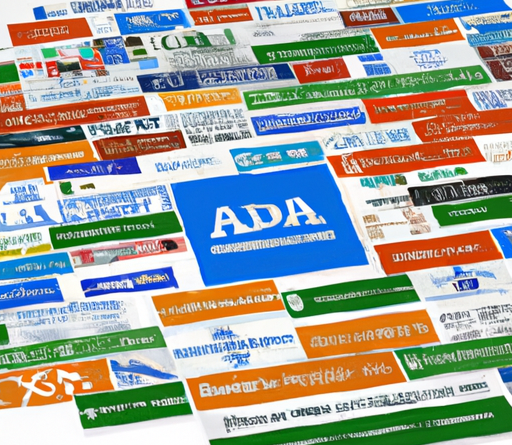
Have you ever wondered how the registration costs for “.com” domains stack up against other Top-Level Domains (TLDs)? Well, you’re in luck! In this article, we’ll take a closer look at the pricing structure for “.com” domains and compare it to other TLDs. Whether you’re a business owner looking to establish an online presence or simply curious about the world of domain registration, this article will break down the costs and help you make an informed decision. So, let’s dive in and explore the world of domain registration costs!
1. Introduction to TLDs
What is a TLD?
A TLD, or top-level domain, is the last segment of a domain name. It represents the highest level in the hierarchy of domain names and is often referred to as the domain extension. TLDs play a crucial role in identifying and categorizing websites, allowing internet users to navigate the vast online landscape easily.
Importance of TLDs
TLDs are essential for establishing an online presence. They provide users with a clear indication of the website’s purpose or geographic location. Different TLDs can convey specific meanings or evoke credibility and trust. For businesses and individuals, choosing the right TLD can significantly influence branding, search engine rankings, and overall visibility on the internet.
Different types of TLDs
TLDs can be classified into several categories. Generic TLDs (gTLDs) are widely recognized TLDs like .com, .net, and .org. Country code TLDs (ccTLDs) are specific to particular countries or regions, such as .us for the United States or .uk for the United Kingdom. Additionally, there are newer gTLDs introduced in recent years, offering more specific options like .app, .blog, or .shop. Understanding the differences between these TLDs is crucial in determining the best fit for your website.
2. Understanding .com Domains
What is a .com domain?
A .com domain is a gTLD that stands for “commercial.” It was originally intended for commercial entities but has since become highly versatile and is now widely used by various organizations and individuals. A .com domain is recognized and trusted by internet users globally.
Advantages of .com domains
.com domains have several advantages that contribute to their popularity. Firstly, they have established themselves as the most recognizable and commonly used TLD. This familiarity can instill trust and credibility in potential visitors. Additionally, .com domains have a broader reach and can easily cater to an international audience. From a branding perspective, .com domains are versatile and offer greater flexibility in terms of content or business type.
Popularity and demand of .com domains
.com domains have witnessed immense popularity and widespread demand over the years. This can be attributed to their association with businesses and their historical dominance on the internet. Due to this high demand, securing a short, relevant, and memorable .com domain can be challenging and may require creativity or financial investment. However, the credibility and recognition associated with .com domains make them a valuable asset for businesses aiming to establish a strong online presence.
3. Registration Cost Factors
Factors influencing domain registration costs
Several factors can influence the registration costs of TLDs. One of the primary factors is the popularity and demand for a specific TLD. TLDs with high demand, such as .com, often come with a higher price due to their desirability and scarcity. Other factors include the administrative costs associated with managing the TLD, marketing investments made by the registry, competition among TLDs, and the reputation of the TLD.
Comparison of pricing models for TLDs
Pricing models for TLDs can vary depending on the registry. Some TLDs adopt a fixed pricing structure, ensuring a consistent registration fee regardless of the domain name or demand. On the other hand, some TLDs implement tiered pricing, where the cost may vary based on the domain name’s desirability, length, or other factors. Understanding these pricing models is crucial for budgeting and determining the value of different TLDs.
Registry fees and registrar fees
When registering a domain, it’s important to distinguish between registry fees and registrar fees. Registry fees refer to the cost set by the organization managing the TLD, while registrar fees are charged by domain registrars for the service of registering the domain on behalf of the customer. The combination of these fees contributes to the total registration cost. It’s worth noting that different registrars may offer varying prices for the same TLD due to competition and promotional offers.
4. Pricing Comparison: .com vs Other Major TLDs
Overview of major TLDs
Apart from .com, there are several other major TLDs that are widely recognized and used. TLDs such as .net and .org have their distinct purposes and cater to specific types of organizations or websites. Understanding the characteristics and target audience of these TLDs can help determine which TLD aligns best with your website’s goals and objectives.
Comparison of registration costs for .com, .net, .org
When comparing the registration costs for major TLDs like .com, .net, and .org, it’s important to consider the demand and popularity of each TLD. Generally, .com domains tend to have higher registration costs due to their widespread demand and recognition. .net and .org domains, while still popular, may have lower registration costs in comparison. However, it’s essential to evaluate the specific pricing structure offered by individual registrars to identify the best deal for your desired TLD.
Price variations among popular TLDs
Although .com, .net, and .org are well-known TLDs, there can be price variations among different registrars. Some registrars may offer promotional discounts, competitive pricing, or bundled services that can affect the overall cost of registering these TLDs. It’s recommended to explore various registrar options and compare pricing to ensure you obtain the best value for your chosen TLD.

5. Country-Specific TLDs
Exploring country code TLDs (ccTLDs)
Country code TLDs, or ccTLDs, are specific to particular countries or regions. These TLDs help websites target and establish a presence within a specific geographic location. Examples include .us for the United States, .uk for the United Kingdom, and .de for Germany. Choosing a ccTLD can provide localized relevance and potentially enhance SEO for specific target markets.
Comparison of .com with country-specific TLDs
While .com domains have a global appeal, country-specific TLDs can offer distinct advantages for businesses targeting specific regions or markets. By utilizing a country-specific TLD, you can signal to visitors that your business or website is tailored to their locale. However, it’s important to consider the potential limitations of using a country-specific TLD, such as potential reduced credibility for international visitors or limited expansion opportunities.
Benefits and drawbacks of using ccTLDs
Using a ccTLD can provide several benefits, including enhanced targeting of specific markets, improved local search rankings, and increased trust and familiarity among local users. However, there are also drawbacks to consider. For businesses with international aspirations, a ccTLD may restrict scalability and brand recognition. Additionally, managing multiple ccTLDs can be complex and time-consuming. Evaluating the specific goals and limitations of your website is key to determining whether a ccTLD is the right choice.
6. New gTLDs and their Pricing
Introduction to new generic TLDs (gTLDs)
In recent years, new generic TLDs, often referred to as new gTLDs, have been introduced to expand the options available beyond traditional TLDs like .com. These new gTLDs offer greater specificity and branding opportunities, catering to various industries or niches. Examples include .app for mobile applications, .blog for blogs, or .shop for e-commerce websites.
Registration costs and availability of new gTLDs
The registration costs for new gTLDs can vary depending on multiple factors. Some new gTLDs may be priced competitively to encourage adoption, while others may have premium pricing due to their exclusivity or desirability. Availability is another consideration, as some new gTLDs may have a higher demand, making it challenging to secure certain domain names. Understanding the pricing and availability of new gTLDs specific to your industry or niche is important for making an informed decision.
Evaluating value and market acceptance
When considering new gTLDs, it’s crucial to evaluate their value and market acceptance. While new gTLDs offer increased specificity and branding opportunities, their recognition and familiarity may vary among internet users. Factors such as consumer perception, industry adoption, and search engine optimization implications should be considered when determining the value and potential success of registering a new gTLD for your website.

7. Registrars and Pricing Competition
Role of domain registrars
Domain registrars play a crucial role in the registration process, serving as the intermediary between customers and the domain registry. They offer domain registration services, manage domain renewals, and provide customer support. Registrars can impact the pricing of TLDs by offering competitive pricing, promotional discounts, and value-added services.
Comparison of registrar pricing for .com domains
When registering a .com domain, it’s important to compare pricing among different registrars. While the registry fees for .com domains are relatively consistent, registrars can offer varying prices due to competition and service differentiation. Comparing registrar pricing allows you to identify cost-effective options while ensuring reliable customer support and domain management.
Promotions, discounts, and cost variations
Registrar pricing for .com domains can be influenced by promotional offers, discounts, and bundled services. Many registrars use promotions to attract customers, providing discounted or even free domain registrations with specific hosting plans or additional services. It’s worthwhile to explore these promotions and consider the long-term costs and value associated with the registrar’s offerings.
8. Premium Domain Pricing
Definition and concept of premium domains
Premium domains are domain names that are highly valuable or sought after due to their relevance, memorability, or commercial potential. These domains often consist of shorter names, commonly used dictionary words, or specific industry terms. Premium domains can command significantly higher prices due to their perceived value and market demand.
Premium domain pricing models
Pricing for premium domains can follow different models, such as fixed pricing, auction-based pricing, or negotiation-based pricing. Fixed pricing involves setting a specific price for the premium domain, while auction-based pricing allows potential buyers to bid on the domain. Negotiation-based pricing occurs when interested parties negotiate a price with the seller or domain broker. Premium domain pricing ultimately depends on factors such as market demand, historical sales, and perceived value.
Examining premium domains in relation to .com domain costs
When comparing premium domain costs to .com domain costs, it’s important to recognize the significant variations in pricing. Premium domains, particularly those highly relevant or commercially valuable, can command prices ranging from hundreds to millions of dollars. In contrast, .com domains typically have a more affordable price range. While premium domains offer unique branding opportunities, they may not be suitable for all budgets or business goals. Weighing the cost-benefit ratio is key when considering premium domains.
9. Hidden Costs and Additional Fees
Understanding hidden costs of domain registration
Beyond the initial registration cost, there may be hidden costs associated with domain registration. These can include additional fees for add-on services, such as domain privacy protection, SSL certificates, or email hosting. It’s important to carefully review and understand the pricing structure offered by registrars to avoid unexpected costs that may arise during the registration process or when managing your domain.
Add-on services and associated fees
Registrars often provide add-on services that can enhance the functionality and security of your domain. These services, such as domain privacy protection or website builders, may come with additional fees. While these services can be beneficial, it’s essential to evaluate their necessity and consider the associated costs to make an informed decision.
Transfers, renewals, and other cost considerations
In addition to the registration cost, it’s important to consider the fees associated with domain transfers and renewals. Some registrars may charge transfer fees when moving your domain to a different registrar, while renewal fees are typically recurring costs to maintain ownership of your domain. Understanding these costs and any potential price increases upon renewal is crucial in managing your domain in the long term.
10. Final Considerations and Recommendations
Factors to consider when choosing a TLD
Several factors should be considered when choosing a TLD for your website. First and foremost, it’s crucial to align the TLD with your website’s purpose and target audience. Consider the reach and recognition of different TLDs, the geographic relevance, and the branding implications. Additionally, evaluating the competition within the chosen TLD and potential SEO implications are key considerations.
Evaluating pricing and value for domains
When assessing the pricing and value of domains, it’s important to strike a balance between cost, visibility, and credibility. Consider the reputation of the TLD, the registration costs compared to alternative TLDs, and any additional fees or services that may be required. Weighing the value of the chosen TLD in relation to your specific website goals and budget is crucial for making an informed decision.
Recommendations for registering .com domains
For many websites, registering a .com domain remains a highly recommended choice. The .com TLD offers global recognition, credibility, and versatility. However, due to the popularity and demand, it’s essential to plan and secure your desired .com domain in advance. Consider consulting with a trusted registrar and registering your .com domain for an extended period to avoid potential price increases and ensure continuous ownership.








